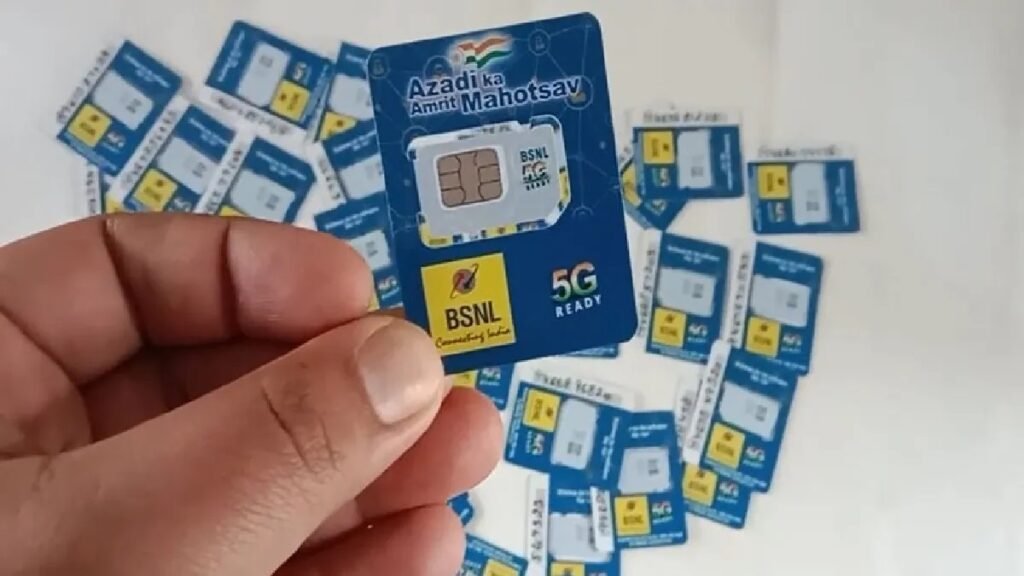BSNL to Launch Universal 4G and 5G SIM with No Geographical Restrictions: A New Era of Connectivity
Bharat Sanchar Nigam Limited (BSNL) is poised to revolutionize the Indian telecom landscape with the imminent launch of its universal 4G and 5G-ready SIM platform. Announced on August 10 by the Department of Telecommunications, this new initiative will break down geographical barriers, providing users with unprecedented freedom in choosing and managing their mobile numbers. In this article, we will delve deep into the implications of this rollout, exploring its potential impact on consumers, the challenges BSNL has faced, and how this new move fits into the broader strategy for the company’s revival.
Breaking Boundaries: What the New BSNL SIM Means for Users
Imagine a world where you can change your SIM card without worrying about geographical restrictions. That’s exactly what BSNL’s new 4G and 5G-ready SIM platform promises. The concept of a universal SIM (USIM) is not just a technical upgrade; it’s a paradigm shift in how mobile services are deliver in India. For the first time, subscribers will have the power to choose their mobile numbers and replace SIMs without being tie to a specific location. This flexibility is expect to be a game-changer for those who frequently travel or relocate, offering seamless connectivity without the hassle of changing numbers or facing regional restrictions.
The Technology Behind the Transformation
So, how does this new SIM platform work? The key lies in the over-the-air (OTA) technology that BSNL is implementing. OTA allows for remote management of SIM profiles, enabling users to switch between 4G and 5G networks effortlessly. This means that as BSNL continues to roll out its 5G services across the country, subscribers can upgrade their network experience without the need for a new SIM card. The USIM platform is design to forward-compatible, ensuring that users can take full advantage of future network upgrades without any additional hardware changes.
The Road to Revival: BSNL’s Struggle and the Government’s Support
BSNL has been battling a severe debt crisis for years, struggling to stay afloat in a highly competitive market dominated by private players. However, the government has stepped in with a series of revival packages aimed at turning the tide for the state-owned telecom giant. The most recent of these was announc last year, with a total outlay of ₹89,047 crore. This package was part of a broader strategy to rejuvenate BSNL, ensuring its survival and enabling it to compete in the rapidly evolving telecom sector.
The First Revival Package: A Lifeline in 2019
The first significant push towards BSNL’s revival came in 2019 when the Union Cabinet, chaired by Prime Minister Narendra Modi, approved a ₹69,000 crore package.
This initial injection of funds provided much-needed stability,
allowing BSNL and its sister company MTNL to address immediate financial challenges and prevent further deterioration of their services.
The package included measures such as voluntary retirement schemes,
the allocation of 4G spectrum, and efforts to reduce the debt burden on the companies.
The Second Revival Package: Strengthening the Foundation
In 2022, the government unveiled a more substantial revival package worth ₹1.64 lakh crore.
This second wave of support was design to address deeper structural issues within BSNL and MTNL.
It include financial backing for capital expenditures,
viability gap funding for rural landlines, and the settlement of Adjust Gross Revenue (AGR) dues.
One of the most significant outcomes of this package was the merger of Bharat Broadband Network Limited (BBNL) with BSNL, streamlining operations and enhancing the company’s ability to deliver high-speed internet services across the country.
The Impact of the Revival Packages: A Turnaround in Sight
The combined effect of these revival packages has started to show positive results.
BSNL, which had been struggling to stay profitable,
began earning operating profits in the financial year 2021-22.
The total debt of the company was reduced significantly from ₹32,944 crore to ₹22,289 crore.
These financial improvements have not only stabilized BSNL but have also laid the groundwork for future growth and expansion,
particularly in the rollout of 4G and 5G services.
The 4G/5G Spectrum Allocation: A New Era for BSNL
A critical component of the government’s revival strategy was the allocation of 4G and 5G spectrum to BSNL through equity infusion.
This move was essential in enabling the company to upgrade its network infrastructure and compete with private telecom operators who had already launched 5G services.
The infusion of capital for spectrum acquisition marked a significant turning point for BSNL,
allowing it to transition from being a laggard in the telecom race to a contender in the high-speed data market.
BSNL’s Universal SIM: A Strategic Move in the Telecom War
BSNL’s introduction of a universal 4G and 5G-ready SIM is more than just a technological advancement; it is a strategic move aim at reclaiming its lost market share. With this new offering,
BSNL is positioning itself as a customer-centric provider,
catering to the needs of modern consumers who demand flexibility and convenience.
The ability to switch networks and manage SIM profiles remotely is expect to attract a new generation of users who prioritize seamless connectivity and advance features.
Challenges Ahead: Can BSNL Compete with Private Giants?
While the launch of the universal SIM is a positive step,
BSNL still faces significant challenges in its quest to compete with private telecom giants like Jio,
Airtel, and Vodafone Idea. These companies have already established a strong foothold in the market,
offering competitive pricing, extensive coverage, and a wide range of value-added services.
For BSNL to regain its position, it will need to not only match these offerings but also differentiate itself by providing unique features and superior customer service.
The Future of BSNL: What Lies Ahead?
The future of BSNL will depend largely on its ability to leverage the government’s support and its new technological capabilities to win back customers.
The successful rollout of 4G and 5G services will be crucial in this regard.
Additionally, BSNL will need to invest in marketing and customer engagement to rebuild its brand image and regain the trust of consumers who may have switched to private operators over the years.
Conclusion: A New Dawn for BSNL
In conclusion, BSNL’s launch of a universal 4G and 5G SIM platform represents a bold step towards revitalizing the state-owned telecom company.
Backed by substantial government support and a clear strategy for growth,
BSNL is pois to make a significant comeback in the Indian telecom sector.
However, the road ahead is challenging,
and success will depend on the company’s ability to execute its plans effectively and meet the evolving needs of its customers.
As BSNL embarks on this new journey,
it will be interesting to see how it navigates the competitive landscape and whether it can reclaim its position as a leading telecom provider in India.
Conclusion After the Conclusion
Ultimately, this move by BSNL is more than just a technological upgrade—it’s a statement of intent.
It shows that the company is ready to adapt, innovate,
and fight for its place in a fiercely competitive market.
As consumers, we stand to benefit from this renewed competition, with better services,
more options, and perhaps most importantly,
the freedom to choose.
So, keep an eye on BSNL in the coming months;
the telecom landscape in India might just be on the verge of a major shakeup.










